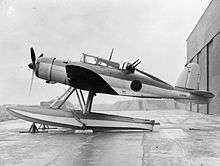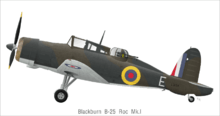Blackburn Roc
| B-25 Roc | |
|---|---|
 | |
| Role | Carrier-based fighter |
| Manufacturer | Blackburn Aircraft Boulton Paul |
| Designer | George Edward Petty |
| First flight | 23 December 1938 |
| Introduction | April 1939 |
| Retired | 1943 |
| Primary user | Fleet Air Arm |
| Number built | 136 |
| Variants | Blackburn Skua |
The Blackburn B-25 Roc was a British Second World War-era Fleet Air Arm fighter aircraft designed by Blackburn Aircraft Ltd. It took its name from the mythical bird of the tales of the Arabian Nights, the Roc. Derived from the Blackburn Skua and developed in parallel, the Roc differed in its adoption of a turret for its armament. Operationally, the Roc came to be viewed as inferior to existing aircraft such as the Skua, and the type had only brief front line service.
Design and development
On 31 December 1935, the British Air Ministry issued specification O.30/35 for a carrier-based turret-armed fighter.[1] Blackburn proposed a derivative of the Blackburn Skua dive bomber, of which two prototypes had been ordered for the Fleet Air Arm earlier that year, while Boulton Paul proposed the P.85, a redesigned version of its land-based Defiant P.82 turret fighter, with either a Hercules radial or Merlin inline engine.[1][2][3] Although the "Sea Defiant" was expected to be 85 mph (137 km/h) faster, the Roc was chosen.[3]
Like the Skua, the B-25 Roc was a two-seat low-wing cantilever monoplane of all-metal construction, fitted with a retractable tailwheel undercarriage, while its wings folded for storage aboard aircraft carriers. It was powered by a Bristol Perseus radial engine driving a three-bladed propeller, and used the same Boulton Paul power operated gun turret as the Defiant, with four .303 in (7.7 mm) Browning machine guns. It retained the wing-mounted dive brakes of the Skua, with bomb racks under each wing for two 250 lb (110 kg) bombs and eight practice bombs to be carried.[4][5]
On 28 April 1937, the Air Ministry placed an order for 136 Rocs. As Blackburn already had full order books for the Skua and the Botha torpedo bomber for the RAF, it was decided to sub-contract detailed design and production to Boulton Paul at Wolverhampton, which delayed deliveries of the Defiant.[6][7]

The first flight by a Roc was on 23 December 1938; handling was acceptable and better than that of the Skua but its performance was poor, with a maximum speed of only 223 mph (194 kn; 359 km/h).[8][9] It had already been realised by some that this performance was inadequate, with the Fifth Sea Lord (the Chief of Naval Air Services) Alexander Ramsay suggesting in October 1938 that the Roc be abandoned. However production was allowed to continue as cancellation would cause too much disruption for Boulton Paul, instead beginning plans to adapt the aircraft for target towing.[10]
As well as its primary role as a carrier-based fighter, the Roc was also required to be capable of operating as a floatplane, with a conversion kit being designed for a set of floats from a Blackburn Shark to be fitted but the first such conversion proved unstable and in December 1939 it crashed when being tested at Helensburgh Marine Aircraft Experimental Establishment where it had been moved at the start of the war. While the addition of an enlarged ventral fin solved the stability problems, the effect of the floats on the aircraft's performance was too great to be ignored, with maximum speed falling to only 193 mph (168 kn; 311 km/h); plans to form a fighter squadron equipped with Roc floatplanes were abandoned.[11]
Operational history

Delivery of the Roc began to the Skua-equipped 800 and 803 Naval Air Squadrons late in 1939, with three or four Rocs supplementing the Skuas. When 803 Squadron moved to RAF Wick in northern Scotland, to provide fighter cover to the Royal Naval base at Scapa Flow in the Orkney Islands, the Rocs proved ineffective, being described as a "constant hindrance" by the squadron commanding officer, who requested that they be replaced by more Skuas.[12]
During the Allied campaign in Norway a small contingent of Rocs travelled with 800 and 801 Naval Air Squadrons on HMS Ark Royal (803 had abandoned its Rocs to become an all-Skua squadron). They were used to carry out combat air patrols over the fleet and again were of little use, showing inadequate performance to intercept German aircraft.[13]
Skuas and Rocs operated over the English Channel in the summer of 1940 and supported Operation Dynamo and Operation Ariel, the evacuations of Allied forces from Dunkirk and other French ports.[14] Probably the Roc's sole confirmed victory occurred on 28 May 1940, when a patrolling 806 Naval Air Squadron Roc, flown by pilot Midshipman A. G. Day and two Blackburn Skuas, intercepted five Junkers Ju 88s which were attacking a convoy off Ostende in Belgium. Flying underneath the Junkers while the Skuas attacked from above, Midshipman Day's Roc destroyed one Ju 88 before returning safely to RAF Detling.[15] Rocs and Skuas of 801 Naval Air Squadron, strafed and dive-bombed German E-boats in Boulogne harbour on 12 June, damaging several E-boats and on 20 June, Skuas and Rocs were used to bomb gun emplacements at Cap Gris Nez.[16]
The Roc was relegated to air sea rescue and target-towing in various locations - as an example No 2 Anti-Aircraft Co-operation Unit at Gosport received 16 Rocs to replace Blackburn Sharks in June 1940.[17] - some as distant as Bermuda until the last two examples were withdrawn from service in June 1943.[16][18] The last four (non-airworthy) Rocs stationed at HMS Daedalus in Gosport survived until late 1944, their turrets still being used for anti-aircraft defence.[17][19]
Operators
Specifications

Data from British Naval Aircraft since 1912 [21]
General characteristics
- Crew: two
- Length: 35 ft 7 in (10.85 m)
- Wingspan: 46 ft (14.02 m)
- Height: 12 ft 1 in (3.68 m)
- Wing area: 310 ft² (28.8 m²)
- Empty weight: 6,121 lb (2,782 kg)
- Loaded weight: 7,950 lb (3,614 kg)
- Powerplant: 1 × Bristol Perseus XII radial engine, 890 hp (664 kW)
Performance
- Maximum speed: 194 kn (223 mph, 359 km/h) at 10,000 ft (3,050 m)
- Cruise speed: 117 knots (135 mph, 217 km/h) [22]
- Range: 704 nmi (810 mi, 1,304 km) with 70 imp gal (320 l; 84 US gal) long-range tank[22]
- Service ceiling: 18,000 ft (5,500 m)
- Rate of climb: 1,500 ft/min (7.6 m/s)
- Wing loading: 25.6 lb/ft² (125 kg/m²)
- Power/mass: 0.11 hp/lb (0.18 kW/kg)
Armament
- Guns: 4 × 0.303 in (7.7 mm) Browning machine guns in power operated dorsal turret
- Bombs: 8 × 30 lb (14 kg) bombs[23]
See also
- Related development
- Aircraft of comparable role, configuration and era
- Related lists
- List of aircraft of the RAF
- List of aircraft of the Fleet Air Arm
- List of fighter aircraft
- List of aircraft of World War II
References
- Notes
- 1 2 Brew 2002, p. 26.
- ↑ Jackson 1968, p. 399.
- 1 2 Buttler, Tony British Secret Projects: Fighters and Bombers p55
- ↑ Mason 1992, p. 271.
- ↑ Jackson 1968, pp. 411–412.
- ↑ Jackson 1968, p. 412.
- ↑ Buttler, Tony British Secret Projects: Fighters and Bombers p. 54
- ↑ Lumsden and Heffernen Aeroplane Monthly March 1990, p. 149.
- ↑ Brew 2002, pp. 38–39.
- ↑ Brew 2002, pp. 50–51.
- ↑ Willis Aeroplane December 2007, p. 57.
- ↑ Willis Aeroplane December 2007, p. 58.
- ↑ Willis Aeroplane December 2007, pp. 58–59.
- ↑ Thomas 2007, p. 17.
- 1 2 Willis Aeroplane December 2007, p. 59.
- 1 2 Mondey 1994, p. 37.
- ↑ Jackson 1968, pp. 415–416.
- ↑ Dell, John "Dinger". "Blackburn Roc: A short description and appreciation." Archived August 6, 2007, at the Wayback Machine. Dinger's Aviation pages. Retrieved: 17 July 2010.
- ↑ Sturtivant and Ballance 1994, p. 362.
- 1 2 Lumsden and Heffernan Aeroplane Monthly March 1990, p. 150
- ↑ Green 1961, p. 5.
- Bibliography
- Brew, Alec. The Turret Fighters: Defiant and Roc. Ramsbury, Marlborough, Wiltshire, UK: Crowood Press, 2002. ISBN 1-86126-497-6.
- Brown, Eric, CBE, DCS, AFC, RN.; William Green and Gordon Swanborough. "Blackburn Skua and Roc." Wings of the Navy, Flying Allied Carrier Aircraft of World War Two. London: Jane's Publishing Company, 1980, pp. 29–40. ISBN 0-7106-0002-X.
- Green, William. War Planes of the Second World War: Volume Two Fighters. London: Macdonald, 1961.
- Jackson, A.J. Blackburn Aircraft since 1909. London: Putnam, 1968. ISBN 0-370-00053-6.
- Lumsden, Alec and Terry Heffernan. "Probe Probare: Blackburn Skua and Roc Part Two". Aeroplane Monthly, March 1990, Vol. 18, No. 3. pp. 146–150.
- Mason, Francis K. The British Fighter since 1912. Annapolis, Maryland, USA: Naval Institute Press, 1992. ISBN 1-55750-082-7.
- Mondey, David. The Hamlyn Concise Guide to British Aircraft of World War II. London: Chancellor Press, 1994. ISBN 1-85152-668-4.
- Sturtivant, Ray and Theo Ballance. The Squadrons of the Fleet Air Arm. Tonbridge, Kent, UK: Air Britain (Historians) Ltd, 1994. ISBN 0-85130-223-8.
- Thetford, Owen. British Naval Aircraft since 1912. London: Putnam, Fourth edition, 1978. ISBN 0-370-30021-1.
- Thomas, Andrew. Royal Navy Aces of World War 2. Oxford, UK: Osprey Publishing, 2007. ISBN 978-1-84603-178-6.
- Willis, Matthew. "Database: The Blackburn Skua & Roc". Aeroplane, December 2007, Vol. 35, No. 12, pp. 52–69.
- Willis, Matthew. Blackburn Skua and Roc. Sandomierz, Poland/Redbourn, UK: Mushroom Model Publications, 2007. ISBN 83-89450-44-5.
External links
| Wikimedia Commons has media related to Blackburn Roc. |